SEO
Is Wix Good for SEO? Here’s Everything to Know About Wix SEO

As of 2023, Wix provides solid options for a basic SEO setup that will cover most needs but still lacks the flexibility of more advanced and granular settings.
In this article, I go through all the nooks and crannies of Wix SEO options so you can decide if Wix is right for your needs. I’ll also share some tips on how to make your Wix website more search-friendly if you’re already a Wix user.
Wix has a bit of a bad reputation for SEO. This is because from its launch in 2006 until its first big update in 2016, it lacked many basic SEO functionalities like adding alt text and being able to change URL structures.
However, that is no longer the case. You can now do virtually every on-page SEO task using the Wix platform. It even hired expert SEOs, such as Mordy Oberstein and Crystal Carter, who have pushed for more SEO features and better communication.
Back in 2019, we ran a study comparing Wix SEO to WordPress SEO analyzing over 6.4M websites. We found that, on average, far more WordPress websites get organic traffic than Wix websites.

However, we believe that this is due to the website owners, not the platforms themselves. On average, Wix website owners are less tech-savvy (and less educated on SEO) than WordPress users, simply because of the extra learning curve that comes with using WordPress.
Editor’s Note
The study and its methodology weren’t great. Given that there are so many variables involved, we didn’t see a way to rerun it properly. We decided to replace the study with this guide, providing more value to readers and being more fair to Wix.
That said, we had the Wix’s SEO team provide feedback on this article as part of the editing process to ensure accuracy and increase objectivity.

Let’s also see what Googlers have to say about Wix.
Here’s a quote by John Mueller, Google’s senior search analyst, on the topic of Wix SEO:
Wix is fine for SEO. A few years back it was pretty bad in terms of SEO, but they’ve made fantastic progress, and are now a fine platform for businesses. The reputation from back then lingers on, but don’t be swayed by it.
What they’ve done in recent years is really good stuff, including making it trivial to have a really fast site (as you see in the Lighthouse scores — admittedly, speed is only a tiny part of SEO).
If Wix works for them, and they don’t need more, there’s no reason to switch.
So overall, Wix has the majority of features most website users would need to manage SEO. But there’s more to the story…
While Wix has no major SEO issues, it does have three minor issues that may stop you from wanting to use it if you’re serious about search:
- Website builders will typically load slower than custom code – Wix inevitably has code bloat from features you will never use. This is true even if you use WordPress and install a theme builder like Elementor or Thrive Architect, so this isn’t exclusive to Wix. That said, it’s only a minor issue, and it already has great Core Web Vitals compared to other CMS types.
- Less-than-ideal multilingual support – If you plan on publishing your blog posts in multiple languages, you may want to skip Wix. For example, you don’t have full control over the URLs for different language versions of your site. However, some of these aspects are in its feature requests and may be available soon.
- Limited advanced SEO control – Wix lacks some advanced SEO features. For example, it’s difficult to edit the auto-generated sitemap. Additionally, Wix generates cryptic file names for images (e.g., 09a0ab7~mv2.jpg/), which is not good for ranking on Google Images.
Ultimately, Wix’s SEO features will work for most website owners out there.
If you are a business owner who wants to focus more time on running your business and less time on learning how to build the perfect website with the best features, Wix is an excellent choice.
To help you decide if Wix is right for you, we made this helpful table of who should and shouldn’t use Wix to build their website:
| Type of website | Is Wix a great solution? | Explanation |
|---|---|---|
| Personal website | Yes | Wix provides all you need for small websites. |
| Local business | Yes | Wix provides all you need to create a quick and easy local business website and rank in local search results. |
| Affiliate website | Maybe | Wix can handle your needs for affiliate marketing and SEO well. But if you’re aiming to create a big, complex website, it may be worth your time to learn WordPress instead. |
| Content website | Maybe | Wix can handle your needs for content used to show display ads. But if you’re aiming to create a big, complex website, it may be worth your time to learn WordPress instead. |
| Services website | Maybe | If you offer a service such as SaaS, banking, etc., then Wix may be a good choice depending on the specific features needed. You’ll have to do your own research. |
| E-commerce website | Maybe | There’s no perfect out-of-the-box CMS for this. The most common choices are Shopify or WooCommerce, but Wix is a solid option for e-commerce SMBs too. It can handle even some of the more complex e-commerce SEO stuff. |
I personally would never build a website on Wix over WordPress for myself. That’s because WordPress has more features and customizability. And even though it comes with a much steeper learning curve, that is something I’ve overcome. (I’ve been building WordPress websites for over a decade.)
That said, I built my dad a website for his remodeling business using Wix. I did this because it’s much easier for him to go in and edit things himself than it is with WordPress. And he’s able to rank for local keywords just fine on the Wix platform. The website is fairly new, and I will come back in a few months to update this page with the progress of his rankings.
One last thing to keep in mind is that switching your content management system (CMS) can be a massive pain. So whichever tool you choose, be ready to stick to it for a long time.
Deciding to stick with Wix? Here are five Wix-specific tips to help you make sure your website is search-optimized:
1. Complete the Wix SEO Setup Checklist
Wix has a really easy-to-use SEO Setup Checklist built in its platform. To use it, navigate to the Marketing & SEO page, then click Get Found on Google.

From there, you’ll be asked a few questions to get started, such as your business name and the top three to five keywords you want your website to rank for. If you’re not sure which keywords to target, I highly recommend reading our guide to keyword research.
Once you answer the questions, you’ll see a screen with steps you can take to optimize your website for search engines, starting with your homepage.
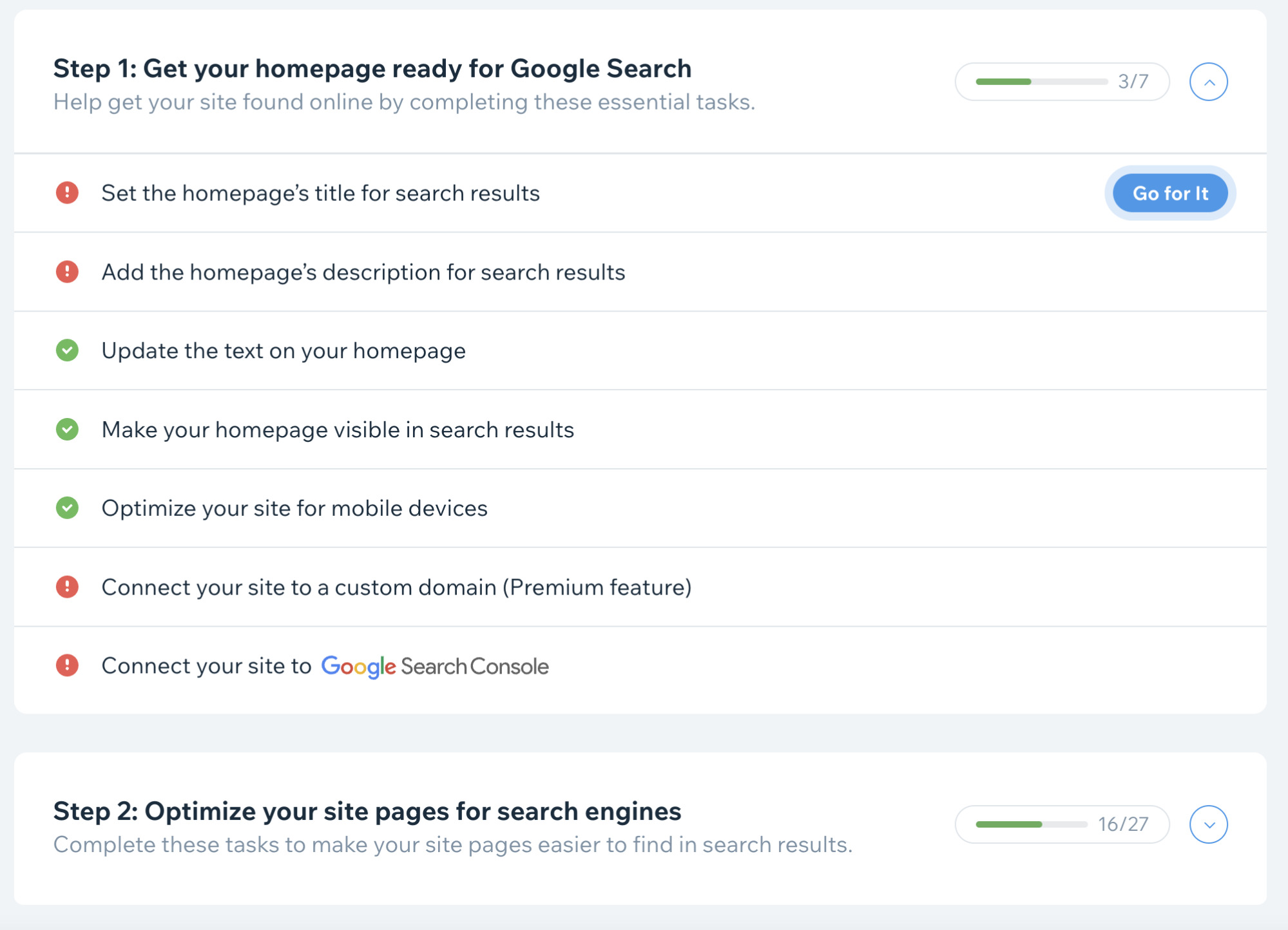
SEO Setup Checklist will guide you through the process of updating your pages’ meta tags, making your website mobile-friendly, and more.
Go through each of these steps, and you’ll be well on your way to a search-optimized website.
2. Set up Google Search Console and Analytics
You’ll notice one of the steps is to connect your site to Google Search Console (GSC). This is Google’s suite of tools designed for website owners like you to more easily monitor your search rankings and find issues preventing your pages from being indexed by Googlebot.
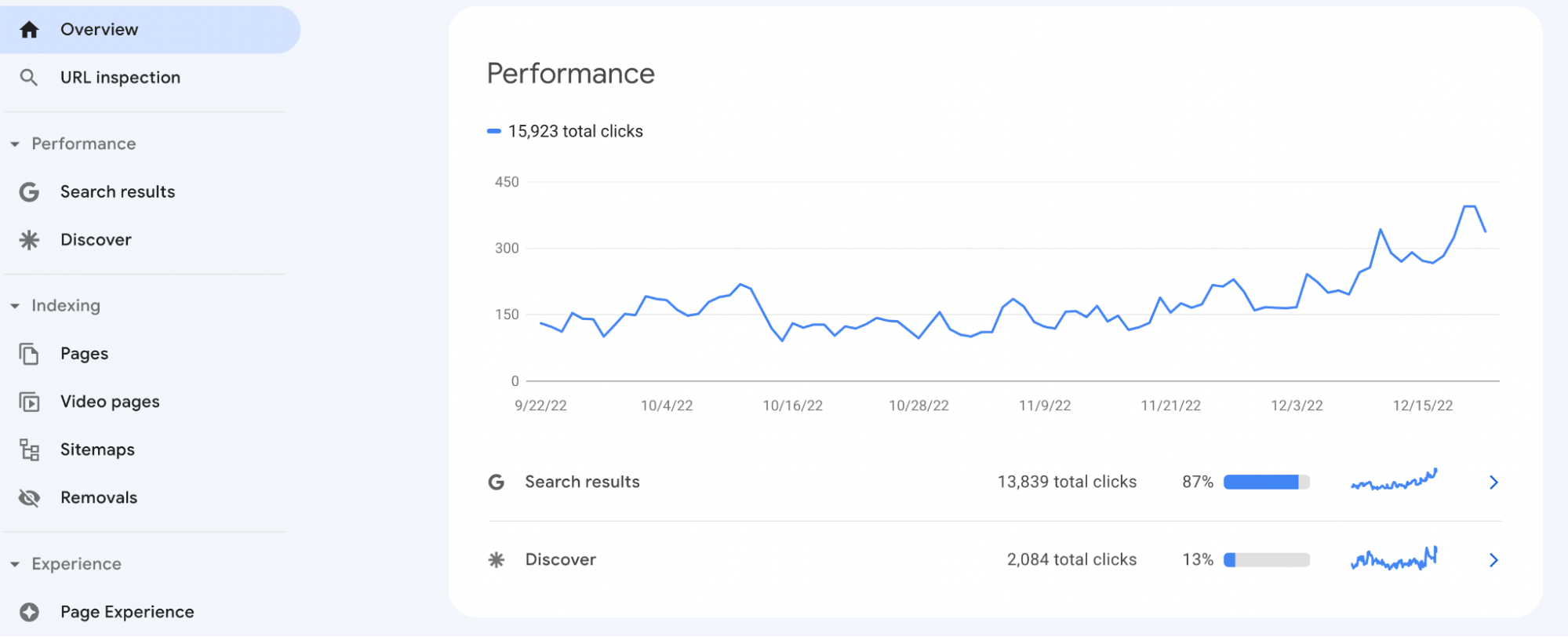
You can set up GSC with the click of a button using the SEO Setup Checklist. If you want to learn more, check out our complete guide to Google Search Console.
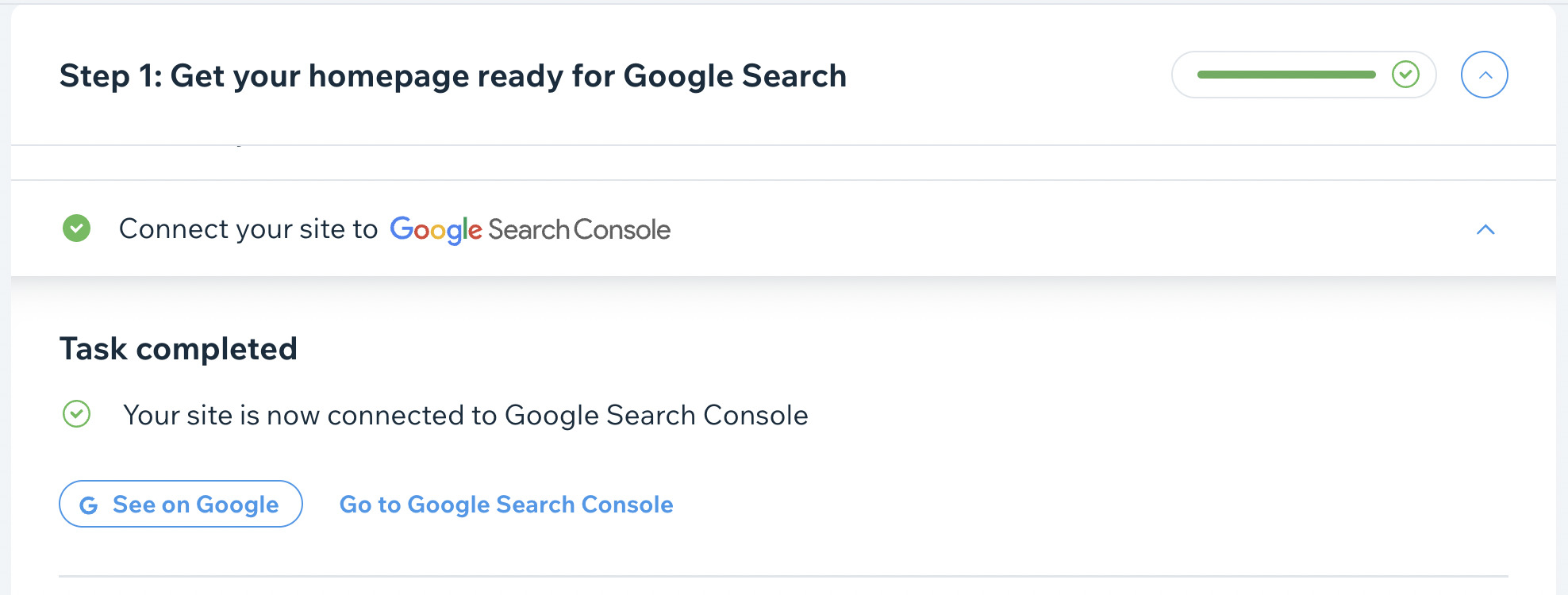
Once GSC is set up, you can connect Google Analytics (GA) to your website to get more insights into where your traffic is coming from and which pages your visitors are going to.
To connect GA, navigate to the Marketing Integrations tab under Marketing & SEO. It’s the first box that appears—click Connect.
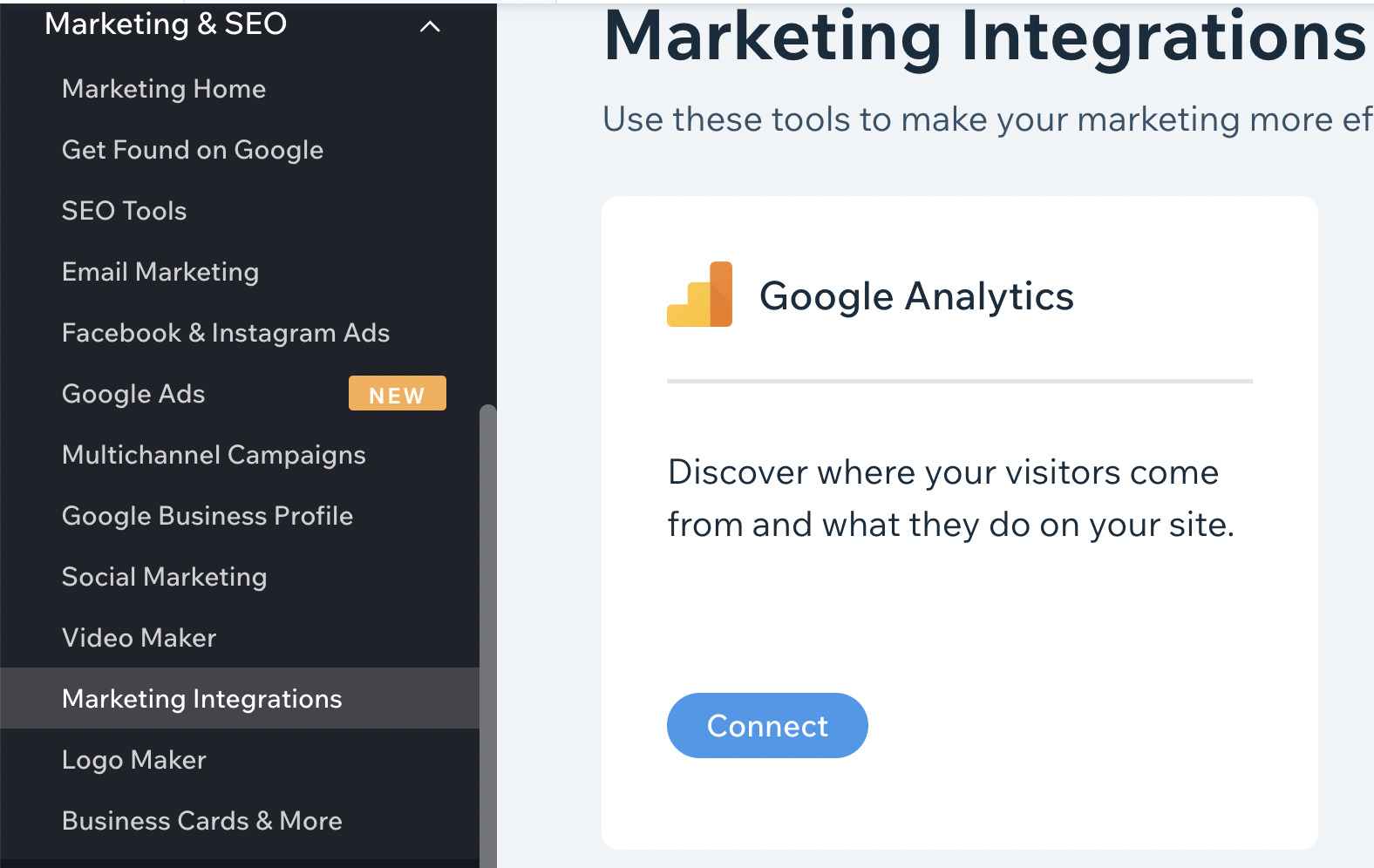
Wix will instruct you on how to create a Google Analytics Property ID and connect that ID with your Wix website. If you need more help, we also have a guide on Google Analytics 4.
Once it’s set up and your website starts getting traffic, you’ll be able to see traffic and webpage reports. This can help you identify which pages may need improvements or how many conversions you get from organic traffic.

That’s it—you’re done with step #2.
3. Create search-optimized content
If your website just has the basic homepage, as well as “about” and “contact” pages, chances are you won’t be able to rank well for much (if anything).
A crucial step in SEO is creating content that can be crawled and indexed by Googlebot. That means creating service pages if you’re a local business and possibly also creating blog content targeting relevant keywords to your industry.
Rather than making this whole article about content, I will leave you with a resource. Go check out our guide to SEO content to learn more.
4. Add internal links
Backlinks—links from another website pointing to your website—are one of the most important ranking factors in Google’s algorithm. However, they can be difficult to obtain.
Internal links from one page on your site to another on your site are almost as important as backlinks. But they are much easier to add. You just highlight some text and add the link in.
If you have pages on your website that you want to rank better, simply add more internal links to that page and you’re already on the path to higher rankings. Obviously, just adding some internal links won’t suddenly make you rank #1 for a keyword. But it’s an important—and often overlooked—step on the road to better rankings.
To add an internal link with Wix, simply highlight the text you want to add a link to, click the “chain link” icon, then choose the page you want the link to point to.
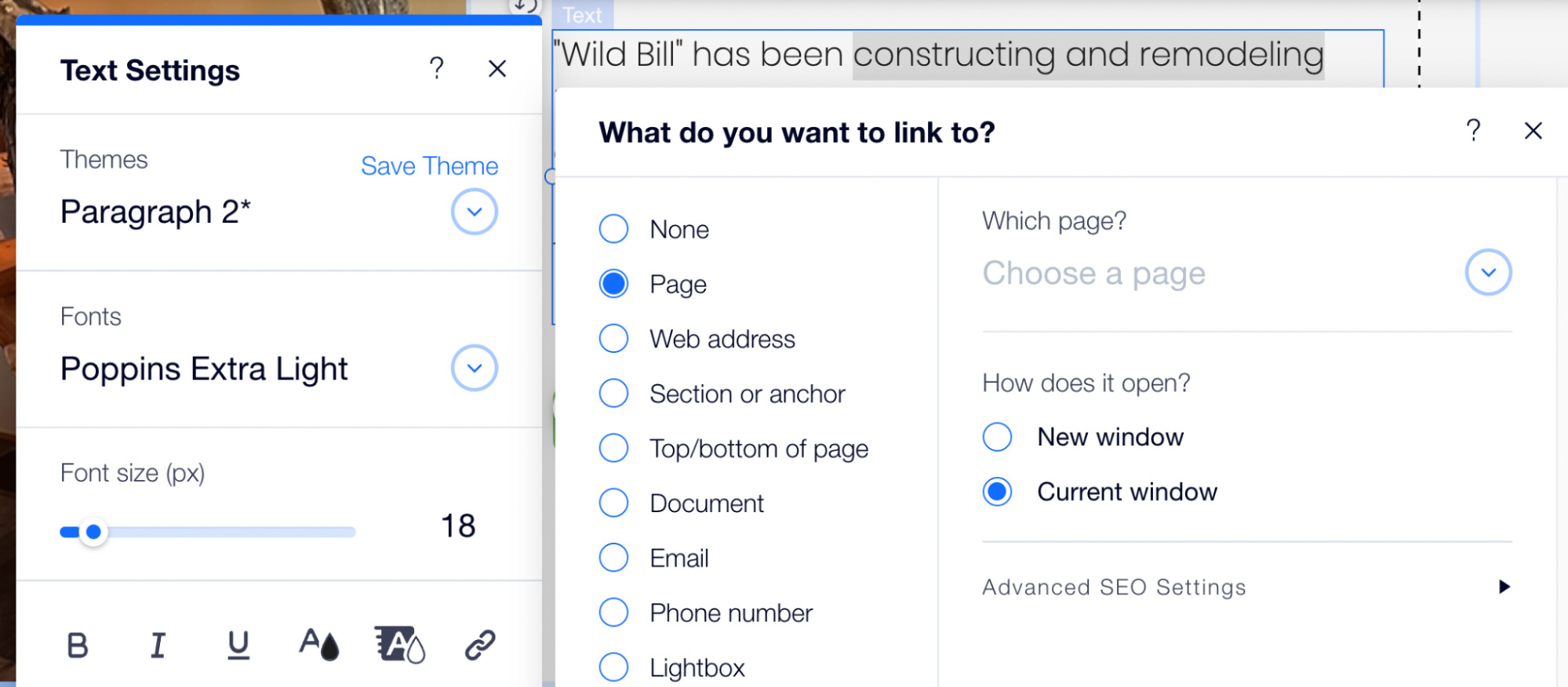
Check out our internal linking guide to learn more about this important SEO task.
5. Schedule regular SEO audits
Once your Wix website is set up and optimized, it’s important to schedule regular SEO audits to keep tabs on your rankings and make sure nothing gets broken.
While you can do this manually, it is time consuming and easy to overlook something.
For example, you may not realize one of your pages broke and is now a 404 page, or that a certain blog post isn’t showing up in your sitemap, or that you’re missing metadata on a certain page… the list goes on.
Instead, you can use Ahrefs Webmaster Tools to automatically run weekly or monthly audits of your website. This free tool will give you a health score from 0 to 100 on how “healthy” your website is from an SEO perspective.
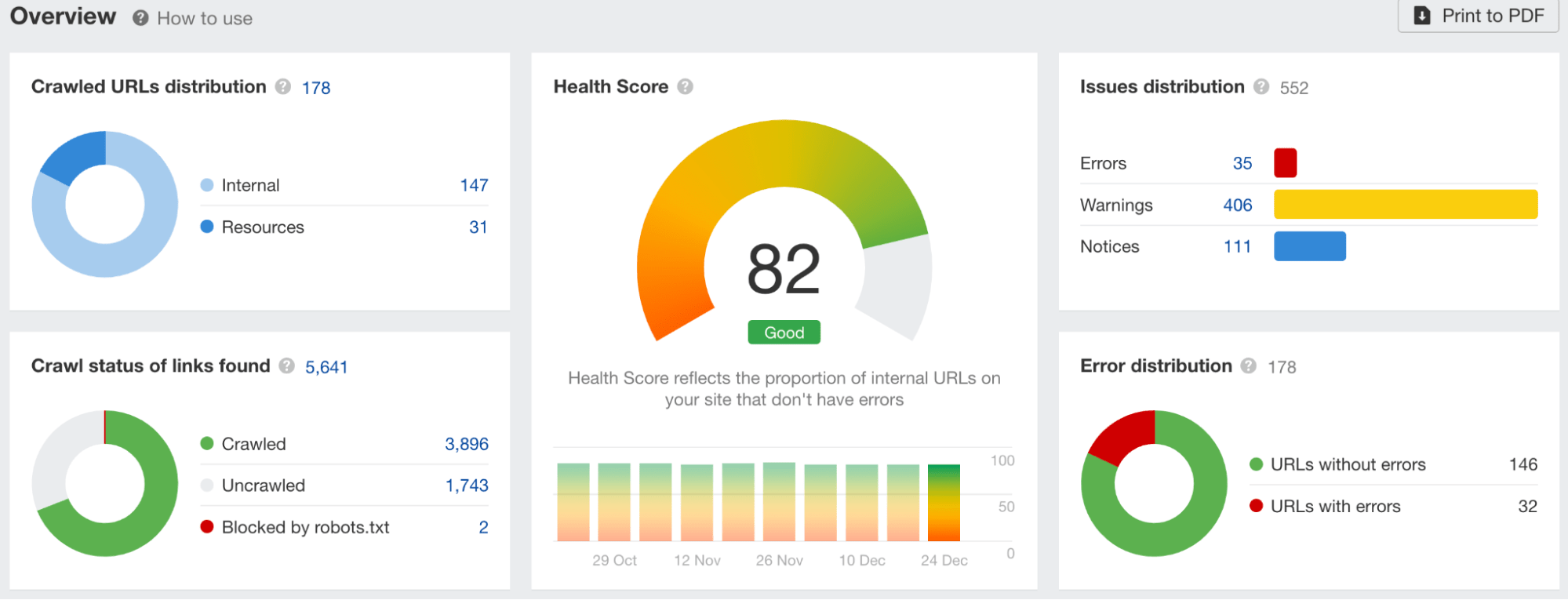
You can then see specific tasks you need to do in order to fix these issues on your site. Go to the All issues report and check the issues we found while crawling your website.
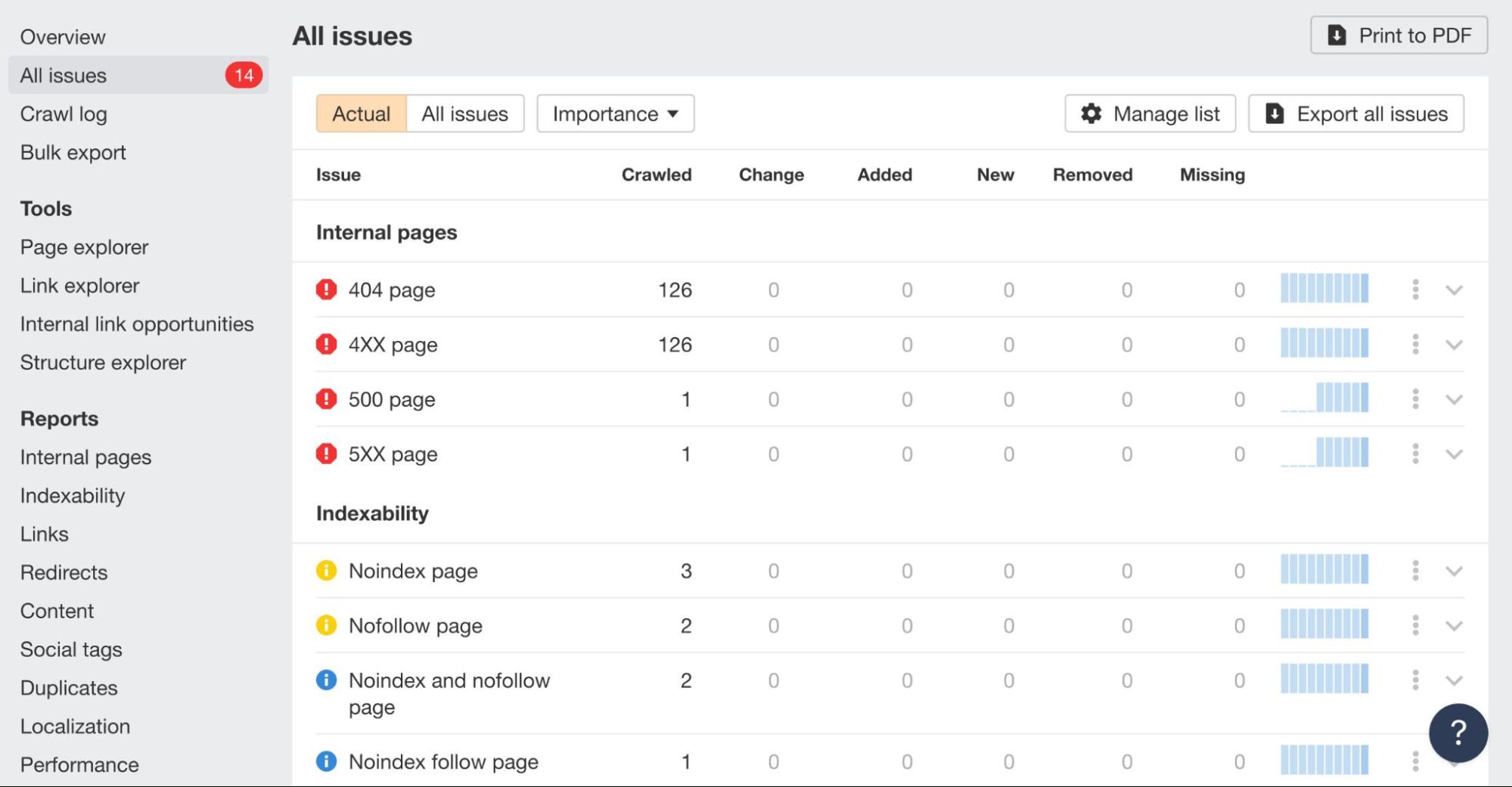
You can click the error and see exactly what it means and how to fix it.
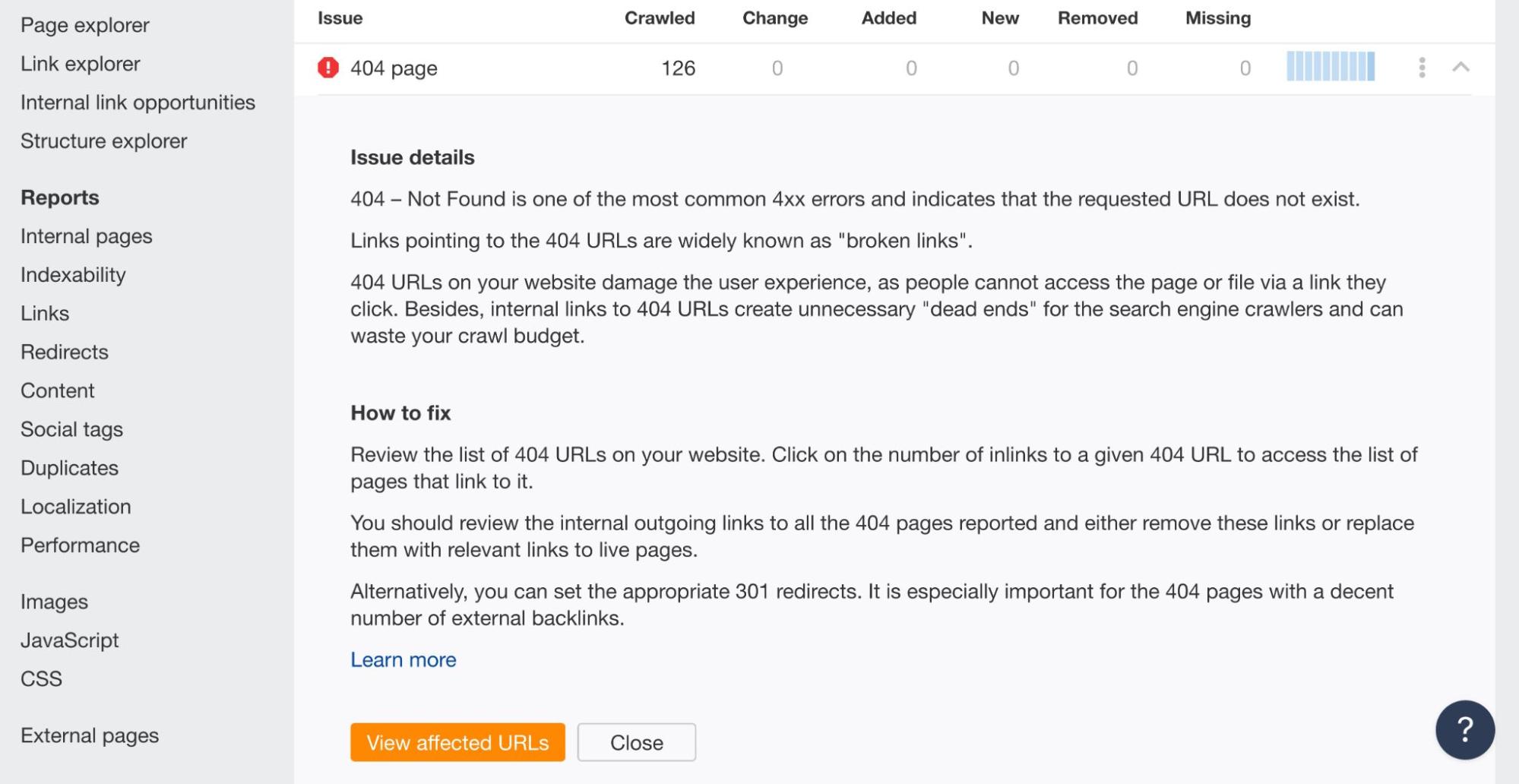
From there, you can click “View affected URLs” and go to those pages to fix the issues. Easy peasy.
Final thoughts
Overall, Wix is a perfectly capable website builder for SEO. While it isn’t as advanced and capable as more complex CMSs like WordPress, it’s plenty good for people who just want to build a website and don’t have the time for or interest in a giant learning curve.
I still use Wix for certain client sites and to build sites for friends and family who want a website where they can still make small edits themselves. It’s my favorite website builder compared to other tools like Squarespace or WordPress.com (not to be confused with WordPress.org, which I use all the time).
One more benefit to using a website builder like Wix is that it’s a complete solution and takes care of the hosting and security. In fact, John doesn’t recommend self-hosting your websites.
That said, if you want more advanced features and to dive deeper in SEO, I suggest learning WordPress.
Ready to keep learning? Here are some other helpful guides:
SEO
How To Write ChatGPT Prompts To Get The Best Results

ChatGPT is a game changer in the field of SEO. This powerful language model can generate human-like content, making it an invaluable tool for SEO professionals.
However, the prompts you provide largely determine the quality of the output.
To unlock the full potential of ChatGPT and create content that resonates with your audience and search engines, writing effective prompts is crucial.
In this comprehensive guide, we’ll explore the art of writing prompts for ChatGPT, covering everything from basic techniques to advanced strategies for layering prompts and generating high-quality, SEO-friendly content.
Writing Prompts For ChatGPT
What Is A ChatGPT Prompt?
A ChatGPT prompt is an instruction or discussion topic a user provides for the ChatGPT AI model to respond to.
The prompt can be a question, statement, or any other stimulus to spark creativity, reflection, or engagement.
Users can use the prompt to generate ideas, share their thoughts, or start a conversation.
ChatGPT prompts are designed to be open-ended and can be customized based on the user’s preferences and interests.
How To Write Prompts For ChatGPT
Start by giving ChatGPT a writing prompt, such as, “Write a short story about a person who discovers they have a superpower.”
ChatGPT will then generate a response based on your prompt. Depending on the prompt’s complexity and the level of detail you requested, the answer may be a few sentences or several paragraphs long.
Use the ChatGPT-generated response as a starting point for your writing. You can take the ideas and concepts presented in the answer and expand upon them, adding your own unique spin to the story.
If you want to generate additional ideas, try asking ChatGPT follow-up questions related to your original prompt.
For example, you could ask, “What challenges might the person face in exploring their newfound superpower?” Or, “How might the person’s relationships with others be affected by their superpower?”
Remember that ChatGPT’s answers are generated by artificial intelligence and may not always be perfect or exactly what you want.
However, they can still be a great source of inspiration and help you start writing.
Must-Have GPTs Assistant
I recommend installing the WebBrowser Assistant created by the OpenAI Team. This tool allows you to add relevant Bing results to your ChatGPT prompts.
This assistant adds the first web results to your ChatGPT prompts for more accurate and up-to-date conversations.
It is very easy to install in only two clicks. (Click on Start Chat.)
For example, if I ask, “Who is Vincent Terrasi?,” ChatGPT has no answer.
With WebBrower Assistant, the assistant creates a new prompt with the first Bing results, and now ChatGPT knows who Vincent Terrasi is.
 Screenshot from ChatGPT, March 2023
Screenshot from ChatGPT, March 2023You can test other GPT assistants available in the GPTs search engine if you want to use Google results.
Master Reverse Prompt Engineering
ChatGPT can be an excellent tool for reverse engineering prompts because it generates natural and engaging responses to any given input.
By analyzing the prompts generated by ChatGPT, it is possible to gain insight into the model’s underlying thought processes and decision-making strategies.
One key benefit of using ChatGPT to reverse engineer prompts is that the model is highly transparent in its decision-making.
This means that the reasoning and logic behind each response can be traced, making it easier to understand how the model arrives at its conclusions.
Once you’ve done this a few times for different types of content, you’ll gain insight into crafting more effective prompts.
Prepare Your ChatGPT For Generating Prompts
First, activate the reverse prompt engineering.
- Type the following prompt: “Enable Reverse Prompt Engineering? By Reverse Prompt Engineering I mean creating a prompt from a given text.”
 Screenshot from ChatGPT, March 2023
Screenshot from ChatGPT, March 2023ChatGPT is now ready to generate your prompt. You can test the product description in a new chatbot session and evaluate the generated prompt.
- Type: “Create a very technical reverse prompt engineering template for a product description about iPhone 11.”
 Screenshot from ChatGPT, March 2023
Screenshot from ChatGPT, March 2023The result is amazing. You can test with a full text that you want to reproduce. Here is an example of a prompt for selling a Kindle on Amazon.
- Type: “Reverse Prompt engineer the following {product), capture the writing style and the length of the text :
product =”
 Screenshot from ChatGPT, March 2023
Screenshot from ChatGPT, March 2023I tested it on an SEJ blog post. Enjoy the analysis – it is excellent.
- Type: “Reverse Prompt engineer the following {text}, capture the tone and writing style of the {text} to include in the prompt :
text = all text coming from https://www.searchenginejournal.com/google-bard-training-data/478941/”
 Screenshot from ChatGPT, March 2023
Screenshot from ChatGPT, March 2023But be careful not to use ChatGPT to generate your texts. It is just a personal assistant.
Go Deeper
Prompts and examples for SEO:
- Keyword research and content ideas prompt: “Provide a list of 20 long-tail keyword ideas related to ‘local SEO strategies’ along with brief content topic descriptions for each keyword.”
- Optimizing content for featured snippets prompt: “Write a 40-50 word paragraph optimized for the query ‘what is the featured snippet in Google search’ that could potentially earn the featured snippet.”
- Creating meta descriptions prompt: “Draft a compelling meta description for the following blog post title: ’10 Technical SEO Factors You Can’t Ignore in 2024′.”
Important Considerations:
- Always Fact-Check: While ChatGPT can be a helpful tool, it’s crucial to remember that it may generate inaccurate or fabricated information. Always verify any facts, statistics, or quotes generated by ChatGPT before incorporating them into your content.
- Maintain Control and Creativity: Use ChatGPT as a tool to assist your writing, not replace it. Don’t rely on it to do your thinking or create content from scratch. Your unique perspective and creativity are essential for producing high-quality, engaging content.
- Iteration is Key: Refine and revise the outputs generated by ChatGPT to ensure they align with your voice, style, and intended message.
Additional Prompts for Rewording and SEO:
– Rewrite this sentence to be more concise and impactful.
– Suggest alternative phrasing for this section to improve clarity.
– Identify opportunities to incorporate relevant internal and external links.
– Analyze the keyword density and suggest improvements for better SEO.
Remember, while ChatGPT can be a valuable tool, it’s essential to use it responsibly and maintain control over your content creation process.
Experiment And Refine Your Prompting Techniques
Writing effective prompts for ChatGPT is an essential skill for any SEO professional who wants to harness the power of AI-generated content.
Hopefully, the insights and examples shared in this article can inspire you and help guide you to crafting stronger prompts that yield high-quality content.
Remember to experiment with layering prompts, iterating on the output, and continually refining your prompting techniques.
This will help you stay ahead of the curve in the ever-changing world of SEO.
More resources:
Featured Image: Tapati Rinchumrus/Shutterstock
SEO
Measuring Content Impact Across The Customer Journey

Understanding the impact of your content at every touchpoint of the customer journey is essential – but that’s easier said than done. From attracting potential leads to nurturing them into loyal customers, there are many touchpoints to look into.
So how do you identify and take advantage of these opportunities for growth?
Watch this on-demand webinar and learn a comprehensive approach for measuring the value of your content initiatives, so you can optimize resource allocation for maximum impact.
You’ll learn:
- Fresh methods for measuring your content’s impact.
- Fascinating insights using first-touch attribution, and how it differs from the usual last-touch perspective.
- Ways to persuade decision-makers to invest in more content by showcasing its value convincingly.
With Bill Franklin and Oliver Tani of DAC Group, we unravel the nuances of attribution modeling, emphasizing the significance of layering first-touch and last-touch attribution within your measurement strategy.
Check out these insights to help you craft compelling content tailored to each stage, using an approach rooted in first-hand experience to ensure your content resonates.
Whether you’re a seasoned marketer or new to content measurement, this webinar promises valuable insights and actionable tactics to elevate your SEO game and optimize your content initiatives for success.
View the slides below or check out the full webinar for all the details.
SEO
How to Find and Use Competitor Keywords

Competitor keywords are the keywords your rivals rank for in Google’s search results. They may rank organically or pay for Google Ads to rank in the paid results.
Knowing your competitors’ keywords is the easiest form of keyword research. If your competitors rank for or target particular keywords, it might be worth it for you to target them, too.
There is no way to see your competitors’ keywords without a tool like Ahrefs, which has a database of keywords and the sites that rank for them. As far as we know, Ahrefs has the biggest database of these keywords.
How to find all the keywords your competitor ranks for
- Go to Ahrefs’ Site Explorer
- Enter your competitor’s domain
- Go to the Organic keywords report
The report is sorted by traffic to show you the keywords sending your competitor the most visits. For example, Mailchimp gets most of its organic traffic from the keyword “mailchimp.”


Since you’re unlikely to rank for your competitor’s brand, you might want to exclude branded keywords from the report. You can do this by adding a Keyword > Doesn’t contain filter. In this example, we’ll filter out keywords containing “mailchimp” or any potential misspellings:


If you’re a new brand competing with one that’s established, you might also want to look for popular low-difficulty keywords. You can do this by setting the Volume filter to a minimum of 500 and the KD filter to a maximum of 10.


How to find keywords your competitor ranks for, but you don’t
- Go to Competitive Analysis
- Enter your domain in the This target doesn’t rank for section
- Enter your competitor’s domain in the But these competitors do section


Hit “Show keyword opportunities,” and you’ll see all the keywords your competitor ranks for, but you don’t.


You can also add a Volume and KD filter to find popular, low-difficulty keywords in this report.


How to find keywords multiple competitors rank for, but you don’t
- Go to Competitive Analysis
- Enter your domain in the This target doesn’t rank for section
- Enter the domains of multiple competitors in the But these competitors do section


You’ll see all the keywords that at least one of these competitors ranks for, but you don’t.


You can also narrow the list down to keywords that all competitors rank for. Click on the Competitors’ positions filter and choose All 3 competitors:


- Go to Ahrefs’ Site Explorer
- Enter your competitor’s domain
- Go to the Paid keywords report


This report shows you the keywords your competitors are targeting via Google Ads.
Since your competitor is paying for traffic from these keywords, it may indicate that they’re profitable for them—and could be for you, too.
You know what keywords your competitors are ranking for or bidding on. But what do you do with them? There are basically three options.
1. Create pages to target these keywords
You can only rank for keywords if you have content about them. So, the most straightforward thing you can do for competitors’ keywords you want to rank for is to create pages to target them.
However, before you do this, it’s worth clustering your competitor’s keywords by Parent Topic. This will group keywords that mean the same or similar things so you can target them all with one page.
Here’s how to do that:
- Export your competitor’s keywords, either from the Organic Keywords or Content Gap report
- Paste them into Keywords Explorer
- Click the “Clusters by Parent Topic” tab


For example, MailChimp ranks for keywords like “what is digital marketing” and “digital marketing definition.” These and many others get clustered under the Parent Topic of “digital marketing” because people searching for them are all looking for the same thing: a definition of digital marketing. You only need to create one page to potentially rank for all these keywords.


2. Optimize existing content by filling subtopics
You don’t always need to create new content to rank for competitors’ keywords. Sometimes, you can optimize the content you already have to rank for them.
How do you know which keywords you can do this for? Try this:
- Export your competitor’s keywords
- Paste them into Keywords Explorer
- Click the “Clusters by Parent Topic” tab
- Look for Parent Topics you already have content about
For example, if we analyze our competitor, we can see that seven keywords they rank for fall under the Parent Topic of “press release template.”


If we search our site, we see that we already have a page about this topic.


If we click the caret and check the keywords in the cluster, we see keywords like “press release example” and “press release format.”


To rank for the keywords in the cluster, we can probably optimize the page we already have by adding sections about the subtopics of “press release examples” and “press release format.”
3. Target these keywords with Google Ads
Paid keywords are the simplest—look through the report and see if there are any relevant keywords you might want to target, too.
For example, Mailchimp is bidding for the keyword “how to create a newsletter.”


If you’re ConvertKit, you may also want to target this keyword since it’s relevant.
If you decide to target the same keyword via Google Ads, you can hover over the magnifying glass to see the ads your competitor is using.


You can also see the landing page your competitor directs ad traffic to under the URL column.


Learn more
Check out more tutorials on how to do competitor keyword analysis:
-

 PPC6 days ago
PPC6 days ago19 Best SEO Tools in 2024 (For Every Use Case)
-
SEARCHENGINES6 days ago
Daily Search Forum Recap: April 18, 2024
-
SEARCHENGINES5 days ago
Daily Search Forum Recap: April 19, 2024
-

 MARKETING6 days ago
MARKETING6 days agoEcommerce evolution: Blurring the lines between B2B and B2C
-

 WORDPRESS5 days ago
WORDPRESS5 days agoHow to Make $5000 of Passive Income Every Month in WordPress
-

 SEO6 days ago
SEO6 days ago2024 WordPress Vulnerability Report Shows Errors Sites Keep Making
-

 WORDPRESS6 days ago
WORDPRESS6 days ago10 Amazing WordPress Design Resouces – WordPress.com News
-
WORDPRESS7 days ago
[GET] The7 Website And Ecommerce Builder For WordPress

















You must be logged in to post a comment Login